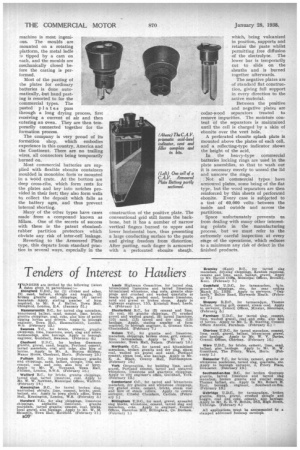Putting the Best Into the Battery
Page 23

Page 24

If you've noticed an error in this article please click here to report it so we can fix it.
A MONGST the many components of
a commercial vehicle, whether it be propelled by, a petrol or oil engine, one of the most vitally important is the battery, which, so often, particularly with the petrol machine, performs such a large number of duties. Its most severe work is, naturally, that of providing power for the engine starter.
In modern vehicles of almost any type the batteries have to meet the requirements of the ordinary lamps and often those for interior illumination; in addition, there are usually the ignition system, electrically operated windscreen wipers, fuel pumps and petrol gauges. Often the mere weight of a battery results in it being roughly handled, and instances are not in
frequent where maintenance men have been observed sliding them up and down steps.
For these reasons batteries built for commercial purposes must be exceptionally strong, able to supply a considerable flow of current over long periods, and. be easily cleaned and repaired.
To meet these requirements the C.A.V. Armoured Plate Battery has been developed, This is manufactured at Birmingham, and marketed by C.A.V.-Bosch, Ltd., Acton, London, W.3.
Last week we spent several most interesting hours at the C.A.V. works at Formans Road, Birmingham, going through the various processes in the production of commercial and other types of battery.
The works impressed us most favourably from the start. They have excellent lighting, electrically controlled windows, ample space for machines, etc., and are maintained in a state of scrupulous cleanliness. Wherever workers are liable to the dangers of dust and fumes, care is taken to minimize these, and the work is performed with glass screens interposed down to the arms; in only a few cases are masks necessary. First-aid rooms and equipment with trained • nurses and a dentist are available.
Dealing with the manufacturing side, practically all the machines, for automatic casting, pasting, etc., are designed and made by the company. This applies also to the numerous moulds, some of which weigh as much as 25 cwt, Die-sinking is carried out to extreme limits of accuracy, and the size of these steel moulds can be realized when one considers the dimensions of the case for a large battery.
One " showpiece " is a 3,500ton hobbing press, which forces hardened hobs into solid blocks of cold steel, thus performing in an hour or two work which formerly took weeks.
The grids for the battery. plates are automatically cast, the heat being controlled by thermostats. 0 n c casting
machine is most ingenious. The moulds are mounted on a rotating platform, the metal ladle ;s tipped by a cam on each, and the moulds are mechanically closed before the casting is performed.
Most of the pasting of the plates for ordinary batteries is done automatically, but hand pasting is resorted to for the commercial types. The pasted plates pass through a long drying process, first receiving a current of air and then entering an oven. They are then temporarily connected together for the formation process.
The company is very proud of its formation shop, which embodies experience in this country, America and the Continent. There are no trailing wires, all connectors being temporarily burned on.
Most commercial batteries are supplied with flexible ebonite containers moulded in monobloc form or mounted in a wood crate. At the bottont are deep cross-ribs, which form rests for the plates and key into notches provided in their feet; they also form wells to collect the deposit which falls as the battery ages, and thus prevent internal shorting.
Many of the other types have cases made from a compound known as Milarn. One of the secrets of success with these is the patent ebonizedrubber partition protectors which obviate any risk of inter-cell leakage.
Reverting to the Armoured Plate type, this departs from standard practice in several ways, especially in the
construction of the positive plate. The conventional grid still forms the backbone, hut it has a number of narrow vertical fingers burned to upper and lower horizontal bars, thus presenting a large conducting surface to the paste and giving freedom from distortion. After pasting, each finger is armoured with a perforated ebonite sheath,
which, being vulcanized in position, supports and retainS" the paste whilst permitting free diffusion of the electrolyte. The lower bar is temporarily cut to slide on the sheaths and is burned together afterwards.
The negative plates are of standard flat construction, giving full support in every direction to the active material.
Between the positive and negative plates are cedar-wood separators treated to remove impurities. The moistuie content of the separators is maintained until the cell is charged by a skin of ebonite over the vent hole.
A perforated ebonite splash plate is mounted above the plates of each cell, and a reflecting-type indicator shows the height of the acid, In the heavy-type commercial batteries locking rings are used in the plate assemblies, so that to wash out it is necessary merely to unseal -the lid and unscrew the rings, .
Not all commercial types have armoured plates, some being of the flat type, but the wood separators are then reinforced by thin sheets of perforated ebonite. Every case is subjected to a test of 60,000 volts between the inside and outside and across the partitions.
Space unfortunately prevents us from dealing with many other interesting points in the manufacturing procesS, but we must refer to the extremely careful inspection at every stage of the operations, which reduces to a minimum any risk of defect in the finished products.
































